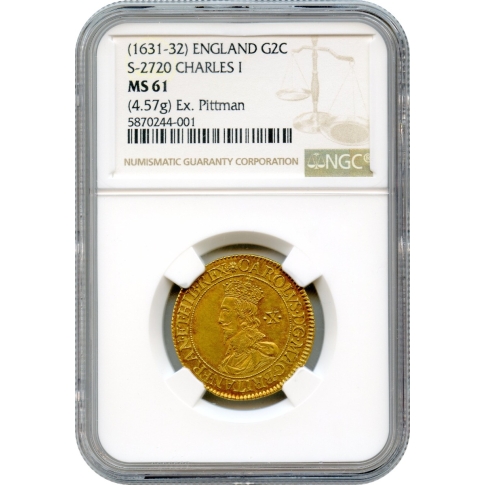World Gold - 1631-1632 Gold Double Crown, Charles I Great Britain (S-2720) NGC MS61
NGC TOP-POP. Charles I (1625-49) gold Double-crown ND, S-2720. Nicholas Briot's milled coinage of 1631-1632. This is a well-centered and neatly struck for this issue, with bold details on a full flan, and pleasing rich orange gold color with a few irridescent highlights. The reverse legend is charming, and was limited in use to the gold crowns and gold double-crowns of this reign, reading in Latin CULTORES SUI DEUS PROTEGIT, in English meaning "God defends those who adore him" As in peace, however, Charles' subjects were of divided loyalty in wartime, and in the end God protected the other side. The coin outlasted the man (as is almost always the case). Ex.Pittman Sale, August 1999, Lot #3732. Quite possibly the Finest Known...certainly the finest graded.
Nicholas Briot (about 1579 – 24 December 1646) was an innovative French coin engraver, medallist and mechanical engineer, who emigrated to England and became chief engraver to the Royal Mint in 1633 and is credited with the invention of the coining-press.
Briot fled to England in 1625, pursued by creditors, and offered his services and machinery to Charles I of England. He met with more success than in France, and in 1626 he was commissioned to make puncheons and dies for 'certain pieces of largesse of gold and silver in memory of his Majesty's coronation', producing his successful Coronation Medal, the first of the sequence of medals for Charles I, in that year. This established his reputation, when he was given 'power and authority to frame and engrave the first designs and effigies of the king's image ... to serve in coins of gold and silver'. He went on to produce a considerable number of dies and moulds for medals and coins in the following years.
In 1633, he was sent to Scotland to prepare and coin the coronation pieces of Charles I, as well as the Scottish Coronation Medal (1633). His Coronation medals and the 'Dominion of the Seas' medal (1630) demonstrated his artistic skill and the technical superiority of the new coining machinery. On the death of Sir John Foulis, Master of the Mint in Scotland, Briot was appointed to the office in 1635, and superintended the Scottish coinage for several years.
Briot was recalled to England by the king and was appointed chief engraver to the Royal Mint in 1633. On the outbreak of the English Civil War he followed Charles I to York and Oxford; 'he took possession of the punches, roller instruments, and coining apparatus at the Tower, by order of his Majesty, and had them removed, trussed up in saddles, at the hazard of his life, for the purpose of continuing the coining operations in the cause of the King'.
He travelled to France in 1641 and 1645, sending presses to his brother Isaac, now in a senior position at the Paris Mint. He died on Christmas Eve 1646.
His dies for coins and medals have been called "gems of medallic art" as his issues display the quality of strike, luster and general appearance of a coin struck 100 or more years later, testimony to Briot's superb die making and minting skills.
Source--Wikipedia
| PCGS # | 140175 |
|---|---|
| Grading Service | NONE |
| Year of Issue | NONE |
| Grade | NONE |
| Denom Type | N/A |
| Numeric Denomination | Gold Double Crown |
| Mint Location | NONE |
| Designation | NONE |
| Circ/UnCirc | Not Specified |
| Strike Type | N/A |
| Holder Variety | S-2720 |
| Grade Add On | NONE |
| Holder Type | N/A |



